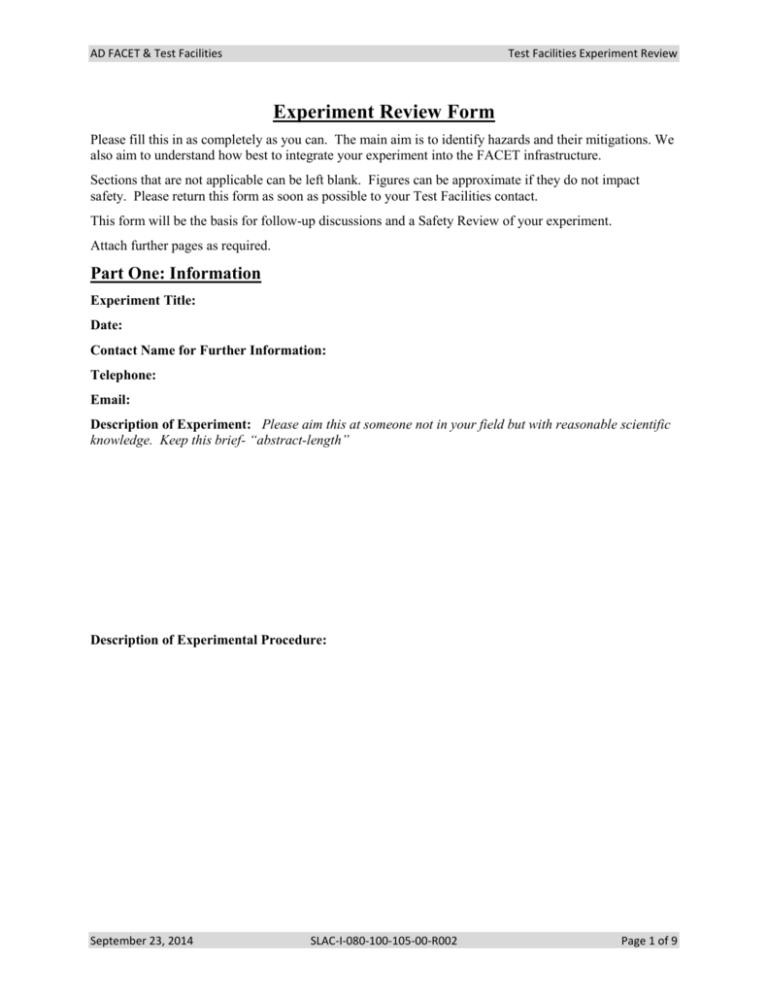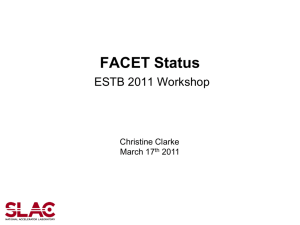Test Facilities Experiment Review (word doc)
advertisement

AD FACET & Test Facilities Test Facilities Experiment Review Experiment Review Form Please fill this in as completely as you can. The main aim is to identify hazards and their mitigations. We also aim to understand how best to integrate your experiment into the FACET infrastructure. Sections that are not applicable can be left blank. Figures can be approximate if they do not impact safety. Please return this form as soon as possible to your Test Facilities contact. This form will be the basis for follow-up discussions and a Safety Review of your experiment. Attach further pages as required. Part One: Information Experiment Title: Date: Contact Name for Further Information: Telephone: Email: Description of Experiment: Please aim this at someone not in your field but with reasonable scientific knowledge. Keep this brief- “abstract-length” Description of Experimental Procedure: September 23, 2014 SLAC-I-080-100-105-00-R002 Page 1 of 9 AD FACET & Test Facilities Test Facilities Experiment Review Part Two: Apparatus You must provide us with drawings and, if possible, computer models. Dimensions of apparatus: Include any support equipment such as vacuum pumps, electronics, etc. Weight (especially note if any item cannot be carried safely down stairs): Lead Shielding Requirements: Description of mechanical controls: Description of electronic controls: Cabling requirements: September 23, 2014 SLAC-I-080-100-105-00-R002 Page 2 of 9 AD FACET & Test Facilities Test Facilities Experiment Review Part Three: Computing Description of controls software: Description of data acquisition systems or computers: Networked resources or software you need access to: September 23, 2014 SLAC-I-080-100-105-00-R002 Page 3 of 9 AD FACET & Test Facilities Test Facilities Experiment Review Part Four: Radiation List All materials and devices that will be in the accelerator tunnel during beam operation: List all samples or other materials that are directly in the beam or could feasibly be in the beam from a beam mis-steer or misalignment of samples. (Include diagnostic screens and devices, sample materials including any supporting substrate, brackets or carriers. State material and length): Please complete the checklist and comment on any “yes” below or on a separate sheet: Yes No Experiment contains: We will use radiological sources We will bring radioactive materials on site (please describe items, history of use and current radiological status) We will bring equipment on site that has previously been exposed to a particle beam, fission or fusion experiments, or may be radiologically activated or contaminated (please describe items, history of use and current radiological status) We will need to take radiologically active materials off site e.g.: samples exposed to the beam (please provide contact details for the radiation safety officer who will receive the materials) We will need to take potentially activated materials off site, including cameras and other instrumentation that has been in the beam tunnel during beam operation. (please provide contact details for the radiation safety officer who will receive the materials) We will use Non-Ionizing Radiation (RF) systems – State frequency and the maximum possible peak and average power. Do not list radiation from normal instrumentation and logic (e.g.: TTL) sources. Comments: September 23, 2014 SLAC-I-080-100-105-00-R002 Page 4 of 9 AD FACET & Test Facilities Test Facilities Experiment Review Part Five: Lasers Will you use a laser as part of your experiment or during the installation of your experiment? If so, state class and type of laser. If you are using Class 3B or Class 4 lasers, please state laser parameters (energy, intensity, pulse duration). You must provide drawings for the layout of the laser beam path with approximate dimensions and descriptions of the optics used. September 23, 2014 SLAC-I-080-100-105-00-R002 Page 5 of 9 AD FACET & Test Facilities Test Facilities Experiment Review Part Six: Electrical Hazards List Electrical Equipment that will need to be EEIP tested on arrival at SLAC: Please complete the following table (examples are given to help you): Potential Electrical Hazards (e.g.: heater leads, high voltage vacuum feedthroughs) Item Heater Leads Hazard Shock hazard - Heaters operate at 150 Volts Vacuum feedthrough Bias voltage for detector – 100 volts September 23, 2014 Mitigation Heater leads are covered when in use. Heater plugs into a nearby connector – avoiding lockout requirement. Bias current is limited by a resistor to 1 mA SLAC-I-080-100-105-00-R002 Page 6 of 9 AD FACET & Test Facilities Test Facilities Experiment Review Part Seven: Gas, Chemical and Material Hazards Yes No Experiment contains: Hazardous Materials. List any material considered hazardous by the State of California Specialized Chemicals. List any chemicals used in the experiment or support equipment. Include pump oils, vacuum greases used on o-rings, etc. Flammable materials. (Materials that can ignite and burn easily at room temperature.) Compressed Gases Potentially pressurized system (Greater than 15 psig.) Cryogens Nano-scale Materials Biological Materials Comments: Please complete the following table (examples are given to help you): Pinch Hazards (for example from moving parts): Item OTR screen September 23, 2014 Hazard Vacuum actuator can pinch personnel Mitigation Actuator is covered SLAC-I-080-100-105-00-R002 Page 7 of 9 AD FACET & Test Facilities Test Facilities Experiment Review Part Eight: Experiment Failure Mitigations Please complete the following tables (examples are given to help you): Identify all potential failure modes of experimental equipment. Include failure modes that are mitigated by engineering or administrative controls. Item Helium pressure regulator failure Hazard High pressure helium can pressurize vacuum chamber OTR screen holder can be hit by beam Damage to cameras by beam shower Mitigation Pressure relief valve installed on low pressure line limits pressure to less than 15 psi Screen mover interlocked to machine protection system to turn off beam during screen motion In your Experimental Procedure, what mistakes can be made? (i.e. what are the failure modes and consequences) Item Dielectric wakefield device can be moved into beam September 23, 2014 Hazard Beam shower, destruction of experiment Mitigation Procedure requires experimenter to monitor secondary electron detector when inserting device SLAC-I-080-100-105-00-R002 Page 8 of 9 AD FACET & Test Facilities Test Facilities Experiment Review The information above is a truthful account of the experimental apparatus and procedures. I agree to provide further information as needed for the experimental safety review. Any changes to the experimental program will be conveyed to the Test Facilities staff using a revised version of this form. Signed: Name: Date: September 23, 2014 SLAC-I-080-100-105-00-R002 Page 9 of 9











